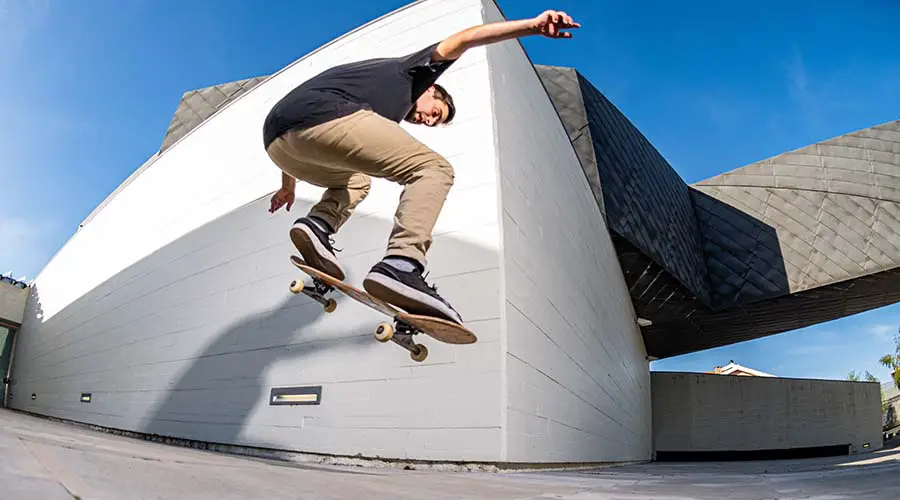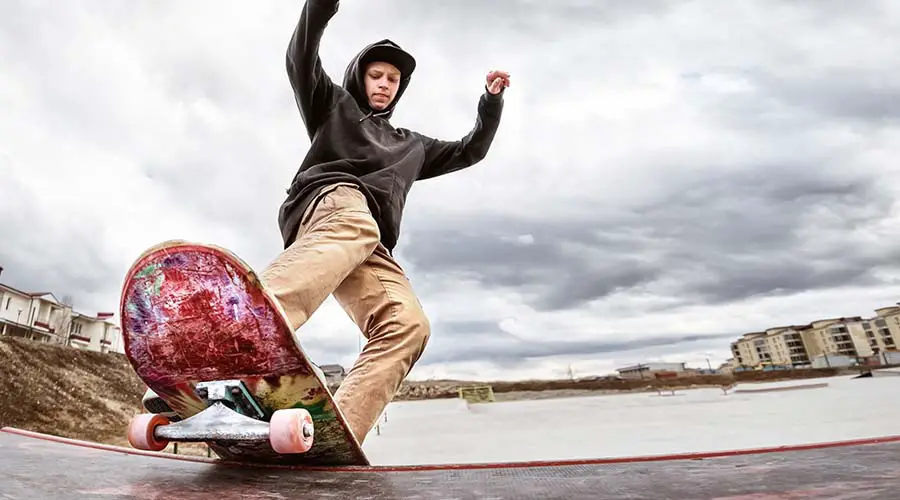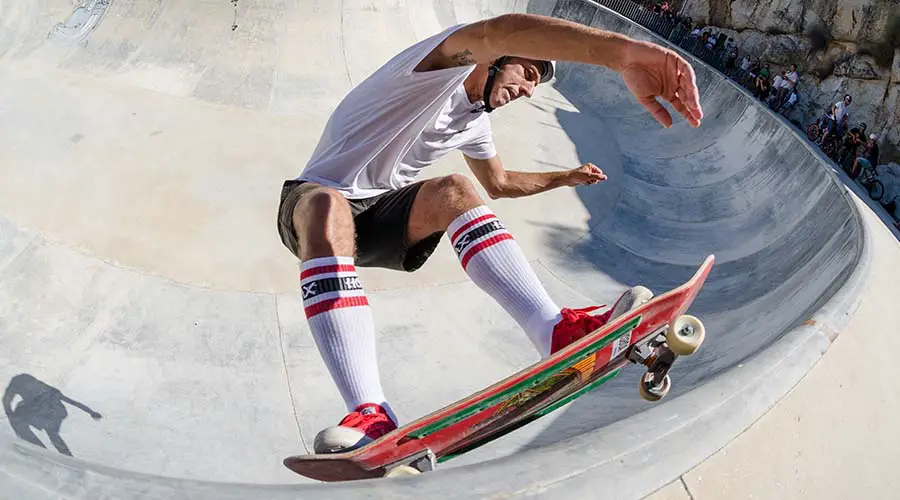Continuing our saga of learning about all sports, especially the Olympic ones, it’s time to find out what the modalities and types of skateboarding are. The sport, which made its debut at the Olympic Games in Tokyo in 2021, emerged in the 1950s in the state of California in the United States.
It all started when surfers wanted to do something when the waves were weak and they couldn’t fall into the sea. So they looked at the board and came up with the idea of making an object that had practically the same shape, but with roller skate wheels.
Since then, the sport has only evolved and, in 1960, it became extremely popular. It’s not hard to see someone skateboarding in a square or even on the street, and to be able to do well at the tricks you need a lot of dedication. It’s no wonder, then, that the sport conquered the Olympics and gained more new fans.

So now it’s time to find out what the modalities and types of skateboarding are, because to compete in the sport it’s not enough just to know how to ride, but to be specialized and have more experience in a particular way of practicing it. But before we understand what these types and modalities are, let’s take a brief historical look at skateboarding!
Participate in our free Whatsapp community and receive daily tips, news and trivia on over 50 sports! Click here to join.
Modalities and types of skateboarding: a brief history of the sport
As we mentioned earlier, the skateboard began in the 1950s, with surfers creating a way of “surfing” on asphalt. Then the board with wheels was created, and they were quite different from the skateboards we know today.
The wheels were made of metal and the board was not concave, i.e. it was straight and this made it very unstable. But with the popularity of the sport, skateboards soon began to gain a better grip, as did the wheels, and they began to be made of a more resistant and softer material.
In the 1970s, skate became even more popular. Consequently, athletes who were incredible at what they did became great icons of the sport. In the 1980s, the development was even greater with skateboarding gaining different maneuvers, whether they took place on ramps or even in urban areas.

It’s worth noting that, in the beginning, skateboarders looked for empty pools to practice their sport. In the 1990s and 2000s, skateboarding evolved even further with the emergence of international and professional competitions, as well as new brands of clothing and special sneakers for skateboarders.
Today, the sport exists globally and has millions of practitioners all over the world! In addition to skateboarding, the sport is part of a lifestyle full of creative expression.
Now that you know the historical context of skateboarding, let’s understand what are the types and modalities of skateboarding? There are different types of skateboard, each for a different sport, and let’s get to know the main ones.
Modalities and types of skateboard: variations of boards and their wheels
- Regular skateboard;
- Street skateboard;
- Vertical skateboard;
- Bowl skateboard;
- Longboard;
- Skate cruiser;
- Electric skateboard.
Regular skateboard
The common skateboard is simpler and more versatile, and can be used for different disciplines. These include street, vertical and bowl.
Street skateboard
On the other hand, skateboards made for street riding are ideal for skating in urban environments, as they have sidewalks, stairs, handrails and even benches. These skateboards are usually lighter and the boards are narrower so that athletes can perform their technical maneuvers.
Vertical skateboarding
This type of skateboard was created for vertical ramps, such as half-pipes, and skate parks. These skateboards tend to be wider on the board and have looser trucks, or axles, so that athletes can be more stable and gain amplitude to perform their maneuvers.
Bowl skateboard
This model of skateboard is designed to be practiced on bowls, which mean bowls in English. These rinks are shaped like empty swimming pools.
For this sport, the skateboards are wider and the axles are tighter, so the athletes can make turns at high speed and remain more stable, with less chance of accidents.
Longboard
The list of types of skateboard also includes longboard-style skateboards, which are longer and wider than the skateboards mentioned above, allowing the athlete to have more stability and comfort when going downhill at high speed. These skateboards are usually used for riding on flat tracks.
Skate cruiser
Cruiser skateboards, on the other hand, are smaller and more agile and are designed for shorter distances. Because they are more portable, they are ideal for getting around town.
Electric skateboard
Electric skateboards are more recent and have a motor and a battery, so the skater doesn’t need to be pushing the skateboard to get around. They are ideal for touring and urban transportation.
Now that we know the best types of skateboard, let’s find out which disciplines are practiced, including in the Olympics!
Modalities and types of skateboarding: competitions
- Street;
- Vertical;
- Bowl;
- Freestyle;
- Downhill;
- Slalom;
- Longboarding.
Street
The first sport to be mentioned is street, which is practiced in urban environments such as squares, streets and parks, where athletes use all possible obstacles to practice, such as stairs, handrails, benches and much more.
This sport is known for having many different and much more technical manoeuvres, each dedicated to a different type of obstacle.
Vertical
The vertical mode is practiced, as its name suggests, on vertical ramps. Thus, skaters perform aerial maneuvers and the best stunts while standing between the flat part and the wall part of the ramp, which makes everything even more impressive.
Bowl
In bowl mode, which is like an empty swimming pool, skaters perform maneuvers similar to vertical skateboarding, exploiting the curves and transitions that the track offers.

Freestyle
Freestyle skateboarding allows athletes to be even more creative. While showing all their technique in freestyle maneuvers, skaters can also combine elements of gymnastics, dance and skating on the skateboard.
Downhill
In downhill skateboarding, skaters descend slopes at high speed. They venture into tight bends while controlling their speed. This sport is basically a competitive race and the roads are closed so that the athletes can race safely.
Slalom
In slalom skateboarding, athletes ride their skateboards along a course with cones that create a path full of short turns. They require a lot of skill and control of the skateboard, and those who complete the course best and fastest win.
Longboarding
The longboard skateboard is basically a sport in itself, as it allows the athlete to explore various disciplines on top of it. The highlight is downhill skateboarding, which consists of high-speed races on slopes.
Modalidades e tipos de skate:
- Regular skateboard;
- Street skateboard;
- Vertical skateboard;
- Bowl skateboard;
- Longboard;
- Skate cruiser;
- Electric skateboard;
- Street;
- Vertical;
- Bowl;
- Freestyle;
- Downhill;
- Slalom;
- Longboarding.
What did you think of learning all about modalities and types of skateboarding? Take advantage of being here and check out our other content on this and other sports, including those that will be the talk of the Paris Olympics, which take place in July 2024.
Don’t forget to leave a comment, tell us what you thought of the article and tell us which other sports you’d like to learn more about here!



